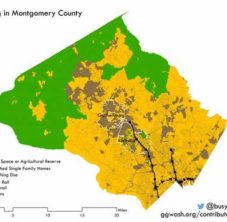I’ve written quite a few posts on the need for zoning reform as a way of reducing the cost of housing. In this matter I hold CMs Friedson and Balcombe in high regard for their efforts in promoting zoning reform.
Driving down Connecticut Avenue on the western border of Section Five in the Town of Chevy Chase, I saw the signs in the lead image and near the intersection of Connecticut Ave. and Thornapple St.

(Drive around that neighborhood and you’ll see many such signs.)
Let’s unpack some some of these objections.
First, Mr. Friedson isn’t giving away anything to developers. Even in an oppressive jurisdiction such as Montgomery County there is a respect for property rights that prevents a developer from arbitrarily knocking down a door and forcing the occupants onto the sidewalk along with their Keurig Coffee Makers. What Mr. Friedson’s reform seeks to do is allow homeowners to build duplexes or fourplexes on their lots that are currently zoned for single-family use. Homeowners who don’t want to go to that trouble can indeed voluntarily sell their lots to a developer. If a homeowner doesn’t want to sell, he doesn’t have to sell.
Second, MoCo’s re-zoning plan is not “extreme.” If you want to see what extreme zoning looks like, drive around Chevy Chase Section 5. The houses there are palatial, as are the cars, as are the schools. The streets are paved smoother than a shave at Floyd’s 99 Barber Shop. There is no economic reason why an exclusive, low-density neighborhood exists so close to a dense downtown area such as DC. The only reason those houses can exist is because of zoning laws that prevent anything else from being built in that area.
Now let’s unpack some of the consequences of our current extreme zoning laws.
First, without the steady income they enjoyed during their working years, many retirees need to sell their homes to cover living expenses. Were those retirees able to sell a lot zoned for a fourplex, they would realize a higher sales price. The restrictive zoning is forcing seniors to sell at lower prices and arguably inching them closer to late-age poverty.
Second, the restrictive zoning is blocking out badly needed housing supply. I understand the feelings of long-term residents who want to preserve an environment to which they have become accustomed. Nevertheless, those residents, and all opponents to zoning reform, need to explain why their wants have a higher priority than younger residents’ needs to buy a starter home.
Third, property values typically rise as the allowed density goes up. The government typically increases assessments on land zoned for high density construction and levies taxes accordingly. Here again, opponents of zoning reform need to explain why they are paying lower property taxes than would otherwise be the case after zoning reform.
Lastly, let’s remember what a maligned “developer” does. A developer, just like a restaurant owner and just like an airline company, does only one thing: provide a good that people want. They take on extreme risk and they endure difficult operating environments in order to provide housing that people (hopefully) want to buy. Developers play the role of civil servant much more than the teachers’ union that survives on coercion.
Residents of Section 5, if you want to keep your lifestyle, I’m all on board. But you need to pay your fair share for that lifestyle, and than means paying the property taxes that the county would be due had developers been able to provide the housing everyone else needs.



